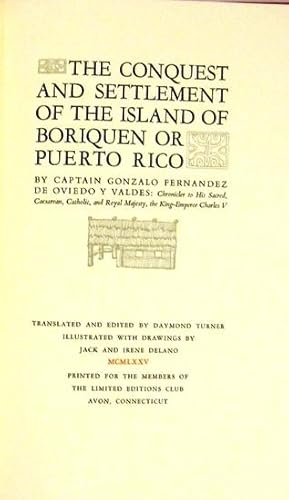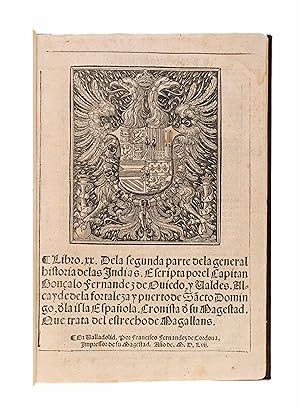gonzalo fernandes (3 resultados)
Tipo de artículo
- Todo tipo de artículos
- Libros (3)
- Revistas y publicaciones
- Cómics
- Partituras
- Arte, grabados y pósters
- Fotografías
- Mapas
-
Manuscritos y
coleccionismo de papel
Condición
Encuadernación
Más atributos
- Primera edición (1)
- Firmado (1)
- Sobrecubierta (1)
- Con imágenes del vendedor
- Sin impresión bajo demanda
Ubicación del vendedor
Valoración de los vendedores
-
Guerras civiles II
Publicado por ALMENA, 2018
ISBN 10: 8494783696ISBN 13: 9788494783692
Librería: Imosver, PONTECALDELAS, España
Libro
Condición: Nuevo. Moreno Zamora, Gonzalo; Vallespín Gómez, Alejandro Ilustrador. Guerras civiles II editado por Almena.
-
THE CONQUEST AND SETTLEMENT OF THE ISLAND OF BORIQUEN OR PUERTO RICO
Publicado por Limited Editions Club, Avon, CT, 1975
Librería: Charles Agvent, est. 1987, ABAA, ILAB, Fleetwood, PA, Estados Unidos de America
Ejemplar firmado
Hardcover. Jack and Irene Delano Ilustrador. Folio (7-1/2" x 12") bound in imported natural vellum-backed scarlet buckram boards with a gilt design. Translated and edited by Daymond Turner. Illustrated with drawings by Jack and Irene Delano including 8 full-page four-color serigraphs silk-screened from the originals by Pava Prints of San Juan. Copy #333 of 2000 SIGNED by both artists on the colophon page and printed at the Stinehour Press. This appears to be the only English translation of this section of Oviedo's HISTORIA GENERAL dealing with Puerto Rico. Monthly Letter laid in. Fine in glassine and just about Fine slipcase.
-
Libro XX
Año de publicación: 1557
Librería: Maggs Bros. Ltd ABA, ILAB, PBFA, BA, London, Reino Unido
Original o primera edición
First edition. Woodcut arms to title-page, 3 woodcut illustrations. Small folio. Full Spanish cat's paw calf. 64ll. Valladolid, Fernandez de Cordova, Rare and important: containing accounts of Magellan's and Garcia Jofre de Loaisa's expeditions, which were the first and second circumnavigations. The work documents the first navigation of the Strait of Magellan and the European discovery of the Philippines. The foremost chronicler of the Indies, Oviedo left behind a vast collection of ill-arranged data on his death, a small portion of which had already been published in his two works on the Indies. The twentieth book was the only part that was to be published in the years immediately after Oviedo?s death and is a stand-alone, separate publication. It is very uncommon (Borba suggests only ten copies are known) but when found is more often than not, as one would expect, bound with either the first or second edition of the Historia. Libro XX follows only Pigafetta and Maximilianus Transilvanus' accounts of Magellan. Oviedo, who had access to one of Pigafetta's surviving mss, drew on both sources providing a richer, more complete treatment of the voyage. Magellan's voyage was intended to establish a western route to the Moluccas (Spice Islands) and he was equipped with five ships and a crew of 237. They departed Seville on 10 August 1519, stopping at Tenerife and then Rio de Janeiro on 13 December. Near Port St Julian in Argentina, a mutiny was quelled and Magellan's crew had their first encounter with the Indigenous population whom they would call Patagonians. It wasn't until 23 October 1520, having already lost one ship, that they entered the Straits of Magellan. They soon lost another as the San Antonio defected and returned to Spain, though entered the Pacific on 28 November. Sailing across the ocean, many of the crew contracted scurvy and dysentery and it was only landfall at San Paolo Island that granted the expedition a temporary reprieve. They reached the Marianas (Guam) before becoming the first Europeans to visit the Philippines. Caught up in a regional conflict, Magellan was killed trying to capture a neighbouring island. The expedition's sole seaworthy ship, the Vittoria, carrying 47 crew, crossed the Indian Ocean and arrived at Sanlúcan on 6 September 1522. The cargo included 533 hundredweight of cloves. The rest of the work (92pp) is concerned with the second trans-Pacific expedition to the Spice islands, commanded by Garcia Jofre de Loaisa. Here the sources appear to be two members of the expedition Martin de Islares and a cleric, Juan de Arecaga, both of whose accounts were previously unpublished. Hitherto Gomara has been considered the principal printed source on this expedition (pub. 1554), and it was used extensively by Burney and others. However the Gomara account is extremely brief, covering some eight pages, and Herrera, Oviedo's successor as official historian of the Indies, writing at the beginning of the next century, devoted only 38 pages of his famous chronicle to the events of the expedition, thus Oviedo's twentieth book has a strong claim to be considered the primary printed source. This ?unhappy? (per Oviedo) expedition was originally commanded by Garcia Jofre de Loaisa. It consisted of six vessels and a pinnace, manned by a total complement of 450. Sailing from Spain in July 1525, they made the coast of Brazil in December after difficulties and adventures during which two of the ships were lost, finally making their way through the Straits of Magellan at the end of May 1526. Separated by a gale, one of the ships the Pataca being low in provisions sailed North and successfully made for the West coast of New Spain. The friar Arecaga was on board and he was able to give news of the expedition to Cortez. Another ship the Santa Maria de la Vitoria commanded by Loaisa steered North West, but the commander fell ill, died, and was succeeded by his second in command Juan Sebastian del Cano (one of the Magellan voyage survivors), who lasted only four days before expiring, when one Alonzo de Salazar took command. By 4th September, 1526, they had sighted the Marshall Islands and made the Marianas Islands where they watered and rested - unlike Magellan, they found the Indigenous population co-operative. Soon after setting a course to the South Salazar was overcome and a new commander Martin Yniguez was elected before they had reached the Celebes. Having reached the Moluccas by November, an intense rivalry grew up between the Portuguese, who were already established, and the depleted Spanish crew. Naval skirmishes between the two continued throughout 1527. In July of that year Yniguez died, poisoned by the agent of the Portuguese, and Hernando de la Torre took over command. In the meantime Cortez fitted out a fleet in Mexico, Alvaro de Saavedra was chosen as commander and he reached Tidore (Borneo), where de la Torre was based, in January 1528. In order to explain the plight of this remote but important outpost Saavedra made a first attempt to re-cross the Pacific, and in so doing discovered Papua, but was beaten back by contrary winds and returned to Tidore. A second attempt was made which again was unsuccessful and cost Saavedra his life, the remaining crew making their way back again to Tidore where de la Torre was gallantly maintaining a Spanish claim. It was not until 1534 that the Spanish left the Spice islands via Cochin and de la Torre reached Spain three years later in 1537. Oviedo y Valdes (1478 ? 1557) is one of the earliest and most reliable chroniclers of the Indies. Having spent over 30 years in America, he witnessed the conquering of the New World by the Spanish, and was present for the return of Columbus in 1493. Church says of his work, mostly referring to the Historia: ?He was Governor of the Province of Carthagena and filled other high positions. The knowledge thus acquired of men and events gave him unusual opportunities for gathering information for this,




